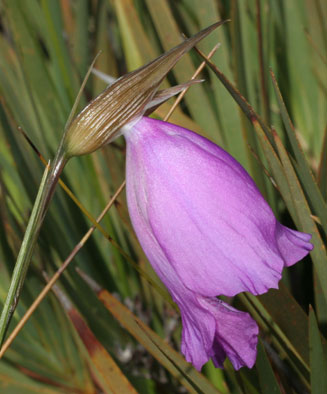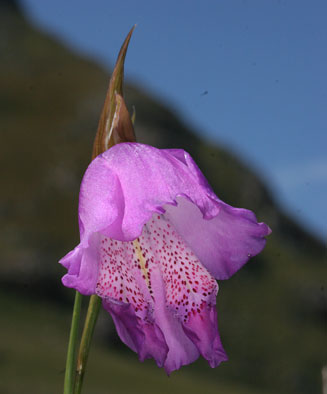|
Gladiolus bullatus (Caledon bell) Life
> eukaryotes >
Archaeoplastida >
Chloroplastida
>
Charophyta > Streptophytina > Plantae (land plants)
> Tracheophyta (vascular plants) > Euphyllophyta > Lignophyta (woody plants)
> Spermatophyta (seed plants) > Angiospermae (flowering
plants) > Monocotyledons > Order: Asparagales
> Family: Iridaceae > Genus:
Gladiolus
  |
|
|
Gladiolus bullatus, Kogelberg
Biosphere Nature Reserve, Kleinmond, Western Cape, South Africa. [photos
H.G.
Robertson, Iziko ©] |
Information is from Goldblatt and Manning (1998).
Distribution and habitat
Endemic to the Western Cape, South Africa, with a
distribution from Houw Hoek and Kogelberg in the west to Bredasdorp and Potberg
(near Cape Infanta) in the east. Grows in low-growing fynbos vegetation, mainly
in stony sandstone-derived soils, but also on limestone outcrops.
Life cycle
- A geophyte, with corms measuring 10-20 mm in diameter.
- Flowers from mid-August to mid-September.
- Seeds ovate, pointed at one end, measuring 4-5 mm long by 3 mm wide,
broadly and evenly winged.
Ecological interactions
On the basis of flower structure and colour, flowers are
probably pollinated by long-tongued bees, but there are no observations to
support this.
Meaning of name
bullatus means bubble-like in Latin and refers to
the inflated, round shape of the flowers.
Publications
- Goldblatt P. and Manning J. 1998. Gladiolus in Southern Africa.
Fernwood Press, Vlaeberg, Cape Town.
Text by Hamish Robertson |
